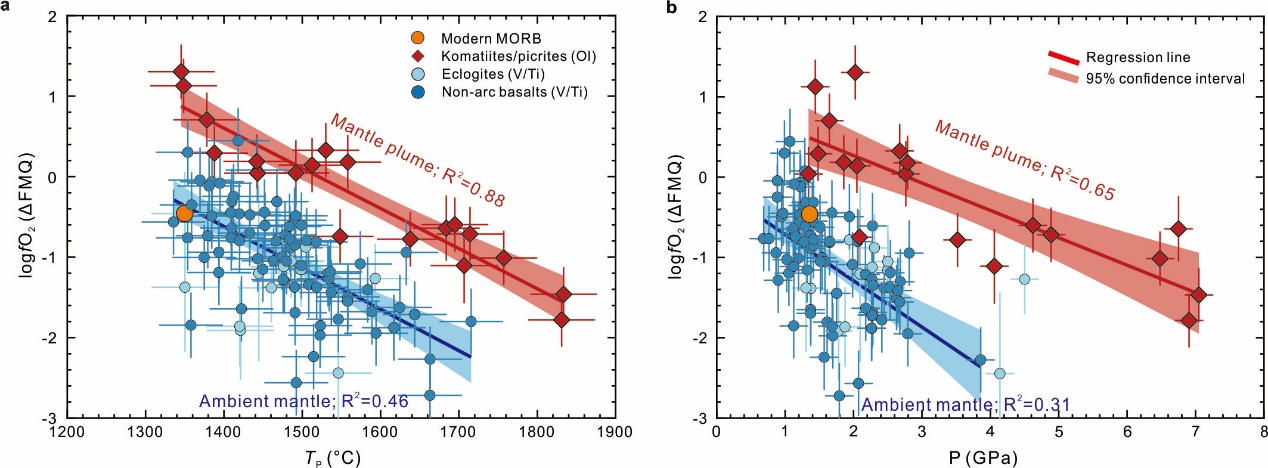Also published on EurekAlert! (https://www.eurekalert.org/news-releases/1054393)
The oxygen fugacity (fO2) of the mantle controls the speciation and mobility of volatiles within it, influencing the composition of volatiles released during mantle-derived magmatic activity, and thereby regulating the composition of the atmosphere.
Researchers from the Institute of Oceanology of the Chinese Academy of Sciences (IOCAS), together with their collaborators, have recently proposed a new parameter, "potential oxygen fugacity", to directly compare the fO2 characteristics of melts formed at different depths.
Current research on the fO2 of the mantle primarily focuses on studying the fO2 of mantle-derived melts. However, due to the increasing stability of Fe3+ in garnet with pressure, mantle fO2 decreases with depth if mantle composition remains unchanged. Therefore, the fO2 differences in melts originating from different depths might reflect variations in the depth of magma origin, which is strongly dependent on the mantle temperature, rather than inherent differences in mantle fO2 (Fe3+/ΣFe ratio).
The parameter researchers proposed is analogous to the classical definition of "potential temperature" and represents the fO2 of the mantle at 1 GPa with an assumption of no melting during the decompression.
Using the "potential oxygen fugacity" parameter allows direct comparison of the redox states of mantle sources from different depths, thereby constraining the evolution of the mantle's redox state.
"Deciphering the evolution of the mantle's redox state since the Hadean is crucial for understanding important scientific questions such as deep carbon cycling, atmospheric composition evolution, and the origins of life," said Dr. ZHANG Fangyi, first author of the study and also a researcher from IOCAS.
The study was published in Nature Communications on Aug. 10.
By establishing the "potential oxygen fugacity" parameter, the researchers collected data on normal ambient mantle-derived basalts and mantle plume-derived komatiites and picrites globally since 3.8 Ga to constrain the evolution of the mantle's redox state and thermal history.
The results showed that the fO2 of Archean magmas was significantly lower than that of post-Archean magmas. Meanwhile, the fO2 of magmas displayed a strong negative correlation with mantle potential temperature and melting pressure.
"This indicates that the high potential temperature of the Archean mantle, causing deep and extensive partial melting, might have resulted in the lower fO2 of Archean magmas," said Dr. ZHANG Fangyi.
After normalizing all mantle-derived magmas' fO2 to the "potential oxygen fugacity", ZHANG and his colleagues found that the fO2 of both ambient mantle and mantle plume sources (lower mantle) has remained constant since the Hadean.
"The variations in the fO2 of mantle-derived magmas were due to changes in melting depth and extent," said Associate Prof. Vincenzo Stagno, co-author of the study and a researcher from Sapienza University of Rome.
Changes in the fO2 of mantle-derived magmas affected the composition of released volatiles and influenced the atmospheric composition. Previous studies suggested that the increase in mantle fO2 since the Archean promoted a rise in atmospheric O2 levels. However, this study reveals that the increase in fO2 of mantle-derived magmas was in fact driven by a long-term cooling of the mantle, which resulted in decreased melting depth and thereby impacted the atmospheric composition.
This study uniquely integrates the thermal state, redox state of the mantle, and atmospheric composition evolution, providing "a new perspective for understanding the co-evolution history of Earth's multi-sphere system," said Prof. SUN Weidong, corresponding author of the study.

Fig. 1 Correlations between the fO2 of mantle derived melts and melting conditions. (Image by IOCAS)

Fig. 2 The redox state of mantle-derived melts is governed by the thermal state of the mantle. (a) In the Archean, a higher mantle potential temperature caused deeper and more extensive mantle melting, resulting in lower fO2 in Archean magmas. (b) Conversely, the Phanerozoic featured a lower mantle potential temperature, leading to shallower melts with increased oxidation due to the mantle's redox structure. The simultaneous cooling and oxidation of mantle-derived melts at the end of the Archean were critical in transforming volcanic gases from an anoxic to an oxic state, potentially triggering atmospheric oxygenation. (Image by IOCAS)
(Text by ZHANG Fangyi)
Media Contact:
ZHANG Yiyi
Institute of Oceanology
E-mail: zhangyiyi@qdio.ac.cn
(Editor: ZHANG Yiyi)

